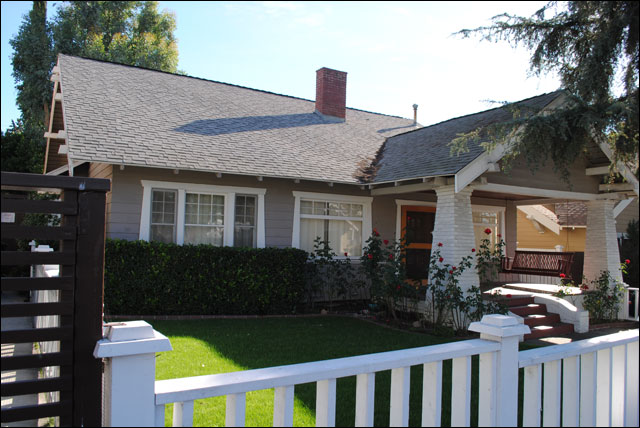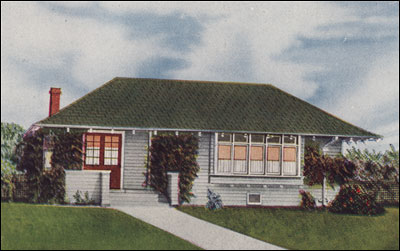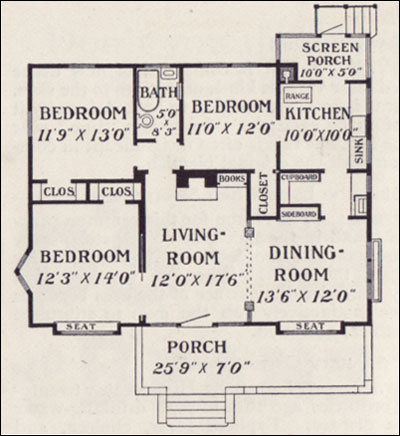The Essential Bungalow: A Definition
What Makes a Bungalow a Bungalow?

Hollywood bungalow with inviting porch
The style "bungalow" doesn't really exist. It is instead a type or form of house. As such, there are a few key characteristics that define a bungalow.
- A large front porch.
- Horizontal orientation.
- An open floor plan.
Without these elements, it's difficult to make a case for a house being a bungalow.
The Bungalow Porch
Even the most modest bungalow had a covered front porch large enough for a chair and small table. The reasons for this critical design element come from numerous directions.
Creating a strong family meant developing a strong community. The last quarter of the 19th century was fraught with tremendous social, economic, and political upheaval, and one antidote to life's uncertainties was to create stability whenever possible. The lowly porch facilitated a modicum of democratic social interaction between neighbors and passersby ... at least in reasonably homogenous neighborhoods. In some respects, it was a public living room. In an age when travel was still by foot, bicycle, and wagon, there was more opportunity to visit with one's neighbors regularly.
Meals were often served and eaten on the porch. In many homes, there was an easy connection between the the living or dining room and the porch. It was not uncommon for the porch to wrap around the house and connect both rooms. So popular and common were these outdoor spaces, women even owned casual at-home garments sometimes referred to as 'porch dresses.' The porch was a critical element in California bungalows with its mild climate and sunshine and exerted a pronounced influence on American residential architecture.
Nineteenth century housing was seen as both a source of and solution to many of society's problems. As science began to identify viruses and bacteria as origin of disease, cleanliness became almost a social fetish. Fresh air afforded by a front porch or sleeping porch quickly came to be seen as essential to maintaining good health. Through its woeful ventilation, tenement housing in the cities demonstrated how bad indoor air quality promoted disease in tightly packed communities. Tuberculosis was particularly feared because it killed thousands of people every year.
The outdoor room as defined by the front porch was both highly practical and symbolic of good health, awareness of nature, and the benefits of a simplified lifestyle.

Horizontal Lines
Almost everything about a bungalow is predicated on a strong horizontal line. Horizontal lines and rectangles define the bungalow form.
Roofs tend to be relatively low pitched and are frequently hipped instead of gabled. Eaves are often wide and create a ground-hugging appearance. They are designed specifically to take advantage of passive solar energy in the winter but cool the interior during the warm summer months.
Windows were often arranged in ribbons that created yet another strong horizontal line. Trim bands often separated shingle from lapped siding in a series of horizonal planes that reinforced the low profile.
The Open Floor Plan

"A Successful Bungalow"—1909 Ladies Home Journal. This is an efficient small house layout by any standard. With a circular floorplan, it minimizes wasted space. The build-ins, including a wall cooler in the unlabeled pantry, would have reduced the need for furniture. The front bedroom could easily have been modified with French doors or a colonnade to extend the line of sight of about 40 feet from the dining room to the outside bedroom wall. Average ceiling heights in bungalows was normally about 9 feet, making fairly small rooms feel much more spacious.
Victorian-period houses were compartmentalized. Rooms were rigidly defined by their function. Lifestyles were more formal, so entrance to a home was more strictly guarded; visitors waited in a reception room or front hall before being admitted to the parlor or sitting room. Private rooms like bedrooms and bathrooms were often on a second floor.
The inner workings of the Victorian-era home might be visible to the guest or not, depending on whether the doors were open or closed. Pocket doors were often used to close the parlor off from the entry. A large formal dining room with its own doors was often situated next to the parlor. As working rooms, the kitchen and pantry also had doors that were were used to keep the noise and smells away from the dining room as much as possible.
To create this healthier home, the bungalow—taking its cue from Japanese residential architecture—threw open the windows and took down the walls to create better ventilation and light as well as to create more flexible interior spaces. During the first two decades of the 20th century, virtually every magazine publisher printed a range of articles on the Japanese influence in home design.
In a bungalow, there might be an "oh, wow!" factor ... often the line of sight was more than 30 feet in many homes. The entry frequently opened directly into the living room, and interior walls were replaced with colonnades or low bookcases. Built-in storage replaced furniture; bookcases and inglenooks flanked fireplaces, buffets and sideboards graced the dining room, and various organizational cabinetry replaced free-standing case pieces. Taken together, it combined to simplify and organize the bungalow's interior. The floor plan shown above might easily have employed the front bedroom as a den, office, library, or music room dispensing entirely with the pocket door if the owner desired.
A feature of the well-designed bungalow was the cross-ventilation in most rooms. Most homes were designed to maximize air flow throughout the house which makes it possible even now to live quite comfortably in many bungalows during the heat of the summer.
Though bungalow aesthetic was influenced by myriad factors, arguably the most prominent was the Japanese appeal to simplicity. Less became more in many homes. In many respects, the bungalow achieved "green" status more than 100 years ago.
Sources
- Saylor, Henry H. Planning the Bungalow. House & Garden Magazine. May 1911.
- White, Charles E. Jr. The Bungalow Book. The Macmillan Company, New York, 1923. Read Chapter 1 at Antique Home Style.
© 2011 — Bungalow Home Style
